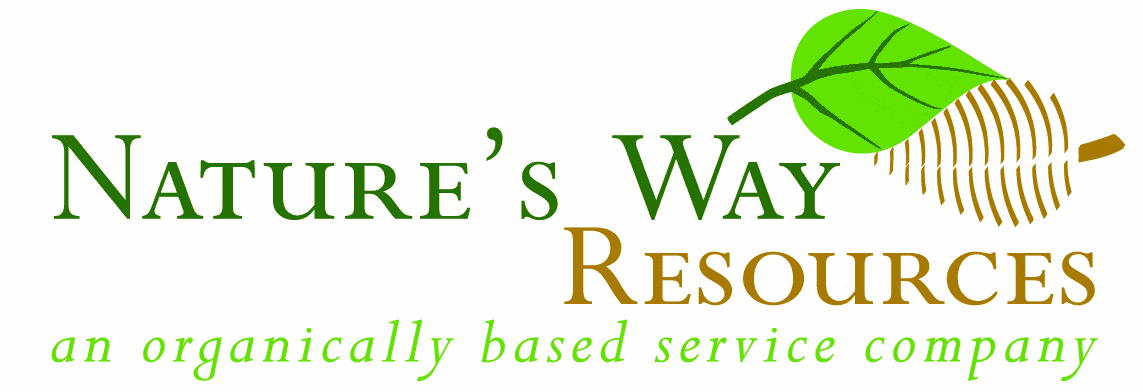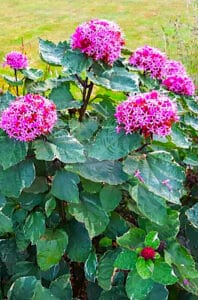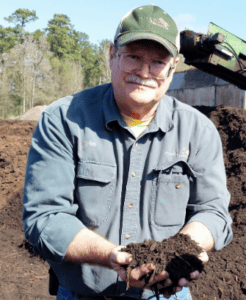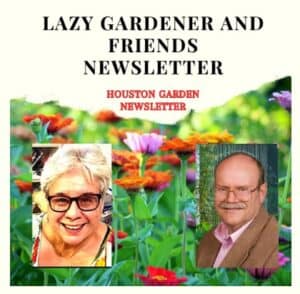 Nature’s Way Resources is proud to produce & email you this free weekly newsletter. We have no ads, but sponsors do graciously help support this project as a public service. Please note their names below & show your gratitude for this free service by patronizing their businesses! To become a sponsor, call (936) 273-1200
Nature’s Way Resources is proud to produce & email you this free weekly newsletter. We have no ads, but sponsors do graciously help support this project as a public service. Please note their names below & show your gratitude for this free service by patronizing their businesses! To become a sponsor, call (936) 273-1200
Nature’s Way Resources owner John Ferguson, “The Lazy Gardener” Brenda Beust Smith and Pablo Hernandez welcome your feedback and are so grateful to the many horticulturists who contribute their expertise
Click here to join our email list
CLICK HERE for PDFs OF PAST LG&F NEWSLETTERS
“On a global basis … the two great destroyers
of biodiversity are, first, habitat destruction and
second, invasion by exotic species.”
— E. O. Wilson, Father of Biodiversity
WHY ARE OLD GARDEN FAVORITES NOW BEING
CALLED INVASIVES?
Pictured: Clerodendrum bungei
Cashmere Bouquet / Mexican Hydrangea
now considered very invasive
BY BRENDA BEUST SMITH
READER JULLI S. wants to know why so many once-popular garden plants are now labeled “invasive”? Changing weather patterns, altering environments, disappearance of natural competitors that kept them under control . . . the reasons are numerous in our constantly changing environment. But things are getting serious now.
I do sympathize. When I was young, we played house under a huge, free-standing “umbrella” violet wisteria shrub in our front yard and sniffed wonderfully scented Japanese honeysuckle. Chinese tallow’s were a welcome sight of fall color we so envied. But they’ve all now turned into bullies, crowding out vital life sources for our native flora and fauna. All three are on Invasive Lists, along with exploding spans of elephant ears, water hyacinths & more “non-native invaders” now clogging our sewers and other waterways. Violet-colored wisteria is killing trees as its roots rapidly spread underground.
Purple-flowered Mexican petunia (Ruellia simplex), beloved by some, may not be by neighbors who find windblown spreading/easily-germinating seeds unwelcome in their yards. Invasive Ruellia tends to grow taller 3-4′ feet. Non-invasive Native Ruellia (ok) usually stays lower, around 18″.
Our many protected prairies now have to schedule regular burns — for many reasons — one of which is to stop nonnative seeds (blown in from neighboring subdivisions and other home gardens). Why? In part to stop our nonnative windblown seed from germinating and overpowering native plants in prairies that wildlife and migrating species need to survive.

Many invasives emit/spread compounds that actually kill off native species. English Ivy climbs trees and shrubs, smothering them and altering forest ecosystems. Nandina has “...escaped into natural areas and can form dense thickets” …. overpowering native plants vital to birds and animals, including migrating ones.
Invasive lantana produces larger, more vigorous, sprawling, denser clumps and a truncated leaf base, with wide range of flower colors that often change with age. Native Texas lantana (pictured) typically has only orange or yellow flowers. More: youtube.com/watch?v=hPk-sh0G4AI.
Confusion this is causing can be so frustrating. But Texas Native Plant Society (npsot.org/) and Lady Bird Johnson’s National Wildflower Center (www.wildflower.org) — both have great lists to double check.
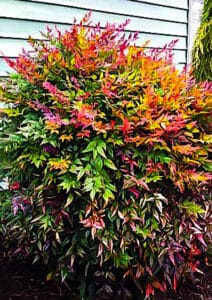 Many invasives actually emit and spread compounds that deliberately kill off native species. For example, as beautiful as they are in fall, Chinese tallow can release potent chemicals that kill off all but their own developing seeds. Nandina:(pictured) has “...escaped into natural areas and can form dense thickets” …. overpowering native plants needed by birds and animals, including migrating ones.
Many invasives actually emit and spread compounds that deliberately kill off native species. For example, as beautiful as they are in fall, Chinese tallow can release potent chemicals that kill off all but their own developing seeds. Nandina:(pictured) has “...escaped into natural areas and can form dense thickets” …. overpowering native plants needed by birds and animals, including migrating ones.
PS: I strongly recommend our HOUSTON GARDENING Facebook website for area gardeners. It’s a wonderful resource with one caution: Doublecheck advice from readers who don’t give their general locations before significantly investing in recommended plants. Some weather differences between far north and far south areas might influence successes
As an unique subtropical area (albeit with multi mini-climates differences), we can still a far grow wider ranges of plants compared to other parts of Texas. But changing weathers will probably trigger even more changes in the future.. Good example: these old favorites mentioned above now labelled invasive for their tendency to overpower and kill out native varieties vital to native /migrating butterflies, birds and other wildlife.

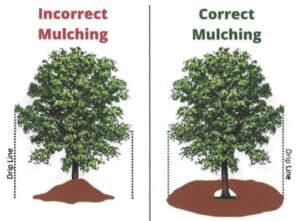
WANT TREES TO THRIVE? WATCH THAT MULCH! Look closely at these trees’ mulches. Vital lifesaving activity takes place where tree trunk touches soil, and extended areas where exposed roots rise above soil level. Never cover! Sometimes trees can handle it, but most times the tree’s health is jeopardized. Big risk. No problem planting around trees as long as you don’t violate this basic precautions.
UNDER TREE CANOPY GARDENS are great when correctly conceived and planted. If not, they can be the tree’s worst enemy. Play it safe:
- Record sun/shade pattern before start, may change with seasons & tree canopy spread,
- Use lawnmower to make dry runs around prospective area, to get idea of most practical size and pattern for your tree..
- Be aware digging in beneath-tree soil can trigger tree root rot and decay.
- Border area with rocks, cover existing soil with mulch (2″ safe depth)
Cover with loose mulch (so those rising tree roots — they might! — and the tree itself can breathe. Use open top & bottom set atop soil & mulch. Adding too much soil might be cutting off oxygen to tree roots. Experts warn:
- Do not add soil within one foot of trunk or over visible tree-spread to prevent bark rot and insect nests.
- Theoretically you can add up to 2″ of soil beyond that open-foot.
- Carefully remove grass/weeds (never herbicides) from planting area with a hand trowel. Mulch well.
- Make holes for planting as small as possible. Better, plant in cylinders so most roots will be above tree roots.
- Professional landscaper tip for greater eye-appeal: repeat these plants or their colors in other nearby gardens.
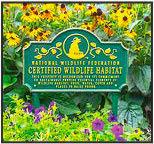 YOU’VE WORKED HARD … and now your landscape is a wildlife haven for local fauna. Let the world know with a yard sign: pictured: National Wildlife Federation Habit designation sign. (Note: both Native Plant Society of Texas and Texas Parks & Wildlife certification programs have been on hold as they now work with the National Wildlife Federation certifications
YOU’VE WORKED HARD … and now your landscape is a wildlife haven for local fauna. Let the world know with a yard sign: pictured: National Wildlife Federation Habit designation sign. (Note: both Native Plant Society of Texas and Texas Parks & Wildlife certification programs have been on hold as they now work with the National Wildlife Federation certifications
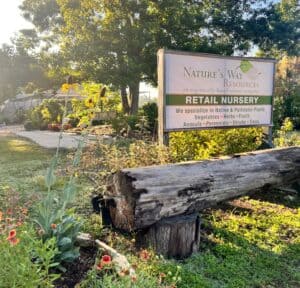 ATTN. GARDEN/PLANT GROUPS — Nature’s Way Resources offers free guided tours of NWR’s extensive nursery/soil/mulch facilities for garden clubs, plant societies and other plant-oriented, organized groups. As usual, NWR’s now-expanded meeting site is free to above groups. Reservations a must for both. Great time to visit!
ATTN. GARDEN/PLANT GROUPS — Nature’s Way Resources offers free guided tours of NWR’s extensive nursery/soil/mulch facilities for garden clubs, plant societies and other plant-oriented, organized groups. As usual, NWR’s now-expanded meeting site is free to above groups. Reservations a must for both. Great time to visit!
- SUBMITTING CALENDAR EVENTS?: For next upcoming newsletter, submit in our exact format (see top of calendar). Otherwise, they may be held for reformatting. PS. Apr, 14 National Gardening Day. – You take it from here!
John’s Corner
NEWS FROM THE WONDERFUL WORLD
OF SOIL AND PLANTS
Subject: Common Gardening Mistakes
Over the years I have encountered many types of problems from consulting with homeowners to landscape architects and engineers on large projects. I have found the success or failure of these projects boils down to a few simple rules or procedures.
These can be summed up by these three simple gardening proverbs:
- Far, far, far, cheaper to put a $1 plant into a $10 hole than a $10 plant in a one-dollar hole!
- It is better to use a little bit of a good product than lots of cheap low-quality products.
- One cannot be a good gardener till you have killed at least a thousand plants.
So, where did these proverbs originate from? We can break it down into several general activities.
Soil Preparation
Not preparing the soil properly before planting is the most common mistake gardeners make. This can range from doing nothing, using a lot of cheap (low quality) products, to repeated tilling destroying the soil. This also includes using toxic chemicals (herbicides and pesticides) that destroy the required beneficial life in the soil.
To prepare one’s soil we need to ensure there are nutrients available for the microbial community to collect and give to the plants. These include major nutrients like nitrogen (N), phosphorus (P), and potassium (K) which are called the major nutrients. Next plants require calcium, magnesium (Mg), manganese (Mn), zinc (Zn), iron (Fe) and a dozen others that collectively that are known as minor nutrients. This is followed by trace elements and micronutrients.
Remember there are 79 elements found in the human body. If they are not in the soil, the microbial army cannot release them and give them to the plants. If they are not in the plants, we do not have them, leading to many health issues.
Providing the nutrients is very easy to do by using a good organic fertilizer like MicrolifeTM along with a trace mineral package like Re-Mineralizer. This ensures that all the elements are in the soil and ready for the microbes to collect and give them to the plant as needed.
Healthy soil is about 25% by volume organic matter. Use good quality leaf mold compost if needed. Mix with fertilizers and minerals into the soil. This is the only time tillage may be necessary to mix amendments together.
Next, we need to mulch as nature hates bare ground. Healthy fertile soil has a carbon to nitrogen ratio of 30:1. Many of the cheaper mulches are over 500:1, they often attract termites or fire ants and many are very flammable. The best mulch is a Native mulch that has been aged (partially composted) as it is a dark chocolate brown color, full of slow-release nutrients and full of beneficial microbes waiting to go to work for you. Over time an aged native mulch will provide microbes to break down clay and turn it into a beautiful rich loam.
Healthy soils are “teaming with microbes” to borrow a phrase. If one uses leaf mold compost and aged native mulch they will supply trillions of microbes.
Avoid using low quality amendments as they cause many problems (See Proverb One).
Another issue one occasionally runs into is compaction. Often the first 1-2 inches are soft, however after that there is compaction as one goes deeper. Compaction causes low oxygen in the soil which limits root development, increases diseases, etc. and prevents water from reaching deep into the soil. To test for compaction, take a large screwdriver and punch into the top 12-18 inches of soil. If it goes down easily you are okay, if not it will need to be addressed as to why it is compacted. If not corrected it can cause problems for decades.
As a bonus earthworms love an aged native mulch and soil with lots of compost. They will diligently work tunneling through one’s soil and reducing compaction and creating tunnels for air and water to move through and into the soil.
Too much fertilizer can cause fast but weak growth that makes plants more susceptible to insects and disease. This is most common when artificial fertilizers are used as they are water soluble chemical salts which can build up and cause compaction.
Chemicals in public water supplies from fluoride to calcium and magnesium carbonates, may build up in the soil and cause compaction. This frequently occurs when one repeatedly over waters.
PLANT CHOICES:
I cannot remember all the times I have seen plants planted in the wrong place. A shade-loving plant in full sun and vice versa, a low water use plant like a cactus in wet area or a swamp plant in sun on a tall berm.
Using non-native plants or non-adaptive plants. Many nurseries sell plants that will not grow well in our climate, this is especially true for box stores and discount places. Most Peony and Rhododendrons need more chill hours and cannot take our heat. Most Bottle brushes cannot tolerate our occasional cold snaps. A gardener needs to make sure the plant material is suitable for our area.
Even using native plants there are differences. We have five sub-species of Black Cherry found in Texas. The ones from East Texas will die in West Texas and vice versa. I have found at my farm near La Grange that I can get plants sourced from a grower in East Texas (spicebush or sassafras for example); they will die despite my best efforts. However, if I get the same species sourced from a grower in San Antonio or Fredericksburg they grow fine. Another example is a Loblolly pine from East Texas which will die at my farm, while the Loblolly pine from Bastrop (Lost Pine area) grows great with less water and in alkaline soils. Slightly different genetics make a difference.
Lack of long-term planning often causes problems. How big will that tree get? What happens to its root systems as they grow? A tree that looked cute when planted close to a house’s foundation when young becomes a danger when it is 50’ tall twenty years later.
I was guilty of this many decades ago. My wife and I purchased our first home on a lot that was stripped bare. So, I planted a few trees around the lot. I also had a beautiful rose garden with over 30 species that were beautiful and fragrant. A few decades later all my roses were gone as the trees shaded them out (Proverb 3).
Occasionally I see issues with a tree grafted onto the incorrect rootstock for our area. This is very common on fruit trees. Certain rootstocks are easier to graft or help the tree grow quicker even though they may not be good for our area, hence growers often sell them especially to box stores and discount nurseries. They may not get enough chill hours, or they are subject to diseases in our humid climate, etc. It is best to go to a reputable private nursery and check with the agricultural extension office as they keep a list of the best type of plants for our area.
Most trees, shrubs, and perennials prefer to be planted in late fall into winter as this allows roots to grow all winter long and become established before the dog days of summer. Container grown plants may still be planted now but will need a little extra TLC to establish. Bare root plants are highly unlikely to be established now without a tremendous amount of TLC.
I planted a couple Barbados cherries last winter that were still actively growing from a local nursery where they had been grown in a greenhouse. When the freeze hit a few weeks later it killed them, as they had not hardened off for the winter. I gambled with nature, and I lost (Proverb 3).
MAINTENANCE PRACTICES:
Over watering encourages shallow root growth, stresses a plant, encourages diseases, increases a plant’s susceptibility to insects, may cause root rot, and more issues. People often overwater since they did not do proper soil preparation. Roots do not go deep (compaction?), or is there a lack of microbes and soil life to create structure to allow rainfall to soak in and be stored?
As an experiment when I lived near Sugarland in the black gumbo clay, I did not water my lawn or garden for over 10 years. During that time my home landscape was featured in a Better Homes and Garden issue. I saved thousands of dollars on water bills by doing a little extra in soil preparation in the beginning.
Mis-diagnosing a problem is sometimes an issue. For example, assuming wilting is a sign of plants needing water when it was a root infection caused by too much water. Do not assume that because the surface is dry, that the root zone is also dry. Take a hand trowel and dig down a few inches and take a look.
Spraying a vegetable or fruit tree with a broad-spectrum pesticide that kills all the pollinators and then wonder why one is not getting tomatoes or peaches. The pesticide killed off all the required insects hence no pollination.
A person may notice the grass dying and treat the area for Brown Patch with a broad-spectrum fungicide. All the fungi get killed off including the ones that break down thatch. As the season progresses one gets a thatch build up, and now they wonder why they have chinch bugs or webworms. You made a good home for them hence nature responded.
Nature is a series of checks and balances, when one applied the artificial fertilizer (salt based) in the spring it killed off the good bacteria in the soil that prevents Brown Patch, starting the merry go round effect.
Volcano mulching is another quick way to have a sick tree with many problems. Trees have two types of bark on them. The bark above ground needs to be dry, it protects the tree from fire or physical damage. The bark below ground is thin, tolerates moisture, and protects the root system. When mulch is piled up around the trunk of a tree the bark that is supposed to be dry gets wet and starts to rot, it makes it easier for insects and animals to eat the inner bark (cambium layer). The tree becomes weaker and has disease or insect problems and will eventually die after a couple of years.
Another issue is that roots may grow into a circle killing the tree or at least weakening it so a storm might knock it over. This is why when planting container grown plants it is a good idea to sperate or cut the roots to prevent circling.
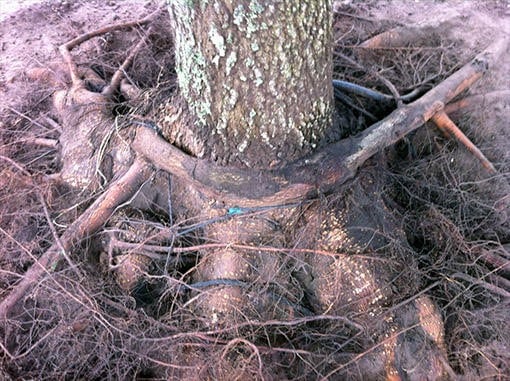
Example of Proverb 2:
The dyed or colored mulches are another way to have expensive problems. The colored mulches require dry wood for the dyes to stick. It is often made from trash wood. Some of the dyes have been found to be carcinogenic.
They have a very high carbon to nitrogen ratio hence rob soils of nutrients stressing the plants as shown in the photo below.

To get dry wood required for the dyes to stick, often trash wood is ground up and used. It is also highly flammable.
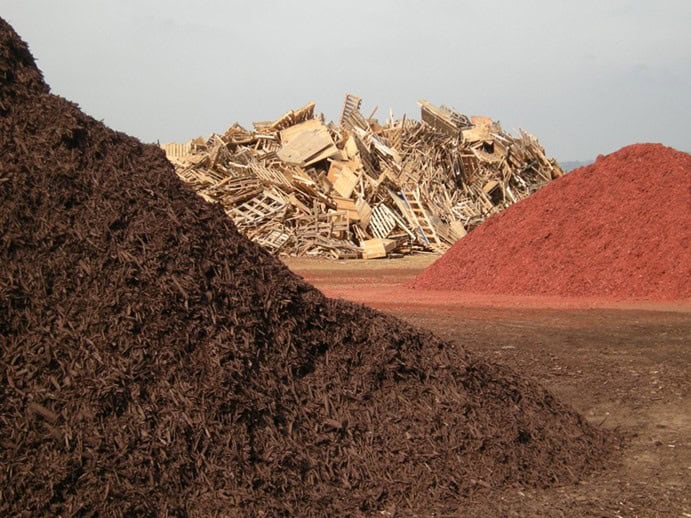
SPONSORSHIP
If you are interested in becoming a sponsor, please contact us at 936-273-1200 or send an e-mail to: lazygardenerandfriends@gmail.com
ABOUT US
BRENDA BEUST SMITH
WE KNOW HER BEST AS THE LAZY GARDENER . . .
but Brenda Beust Smith is also:
- a national award-winning writer & editor
- a nationally-published writer & photographer
- a national horticultural speaker
- a former Houston Chronicle reporter
When the Chronicle discontinued Brenda’s 45-year-old Lazy Gardener” print column — started in the early ’70s as a fun side-project to reporting, it then ranked as the longestrunning, continuously-published local newspaper column in the Greater Houston area. The name, she says, is not just fun, it’s true.
Brenda’s gradual sideways step from reporter into gardening writing led first to an 18-year series of when-to-do-what Lazy Gardener Calendars, then to her Lazy Gardener’s Guide book which morphed into her Lazy Gardener’s Guide on CD, which she now emails free upon request.
Brenda became a Harris County Master Gardener and, over the years, served on theboards of many Greater Houston area horticulture organizations. She hosted local radio and TV shows, most notably a 10+-year Lazy Gardener specialty shows on HoustonPBS (Ch. 8) and her call-in “EcoGardening” show on KPFT-FM.
For over three decades, Brenda served as Assistant Production Manager of the GARDEN CLUB OF AMERICA’S “BULLETIN” magazine. Although still an active broad-based freelance writer, Brenda’s main focus now is THE LAZY GARDENER & FRIENDS HOUSTON GARDEN NEWSLETTER with John Ferguson and Pablo Hernandez of Nature’s Way Resources.
A native of New Orleans and graduate of St. Agnes Academy and the University of Houston, Brenda lives in Humble, TX, and is married to the retired Aldine High School Coach Bill Smith. They have one son, Blake.
Regarding this newsletter, Brenda is the lead writer, originator of it and the daily inspiration for it. We so appreciate the way she has made gardening such a fun way to celebrate life together for such a long time.
About her column, Brenda says: “I don’t consider myself a ‘garden writer.” I started out 50+ years ago as a very lazy “gardening reporter.” I still feel that way today. I hope my columns inspire/help newcomers, but I do not write to them. I write to very experienced gardeners who want to expand their horizons.
JOHN FERGUSON
John is a native Houstonian and has over 35 years of business experience. He owns Nature’s Way Resources, a composting company that specializes in high quality compost, mulch, and soil mixes. He holds a MS degree in Physics and Geology and is a licensed Soil Scientist in Texas.
John has won many awards in horticulture and environmental issues. For years he represented the composting industry on the Houston-Galveston Area Council for solid waste. His personal garden has been featured in several horticultural books and “Better Homes and Gardens” magazine. His business has been recognized in the Wall Street Journal for the quality and value of their products. He is a member of the Physics Honor Society and many other professional societies. John is the co-author of the book Organic Management for the Professional.
For this newsletter, John contributes articles regularly and is responsible for publishing it.
PABLO HERNANDEZ Pablo Hernandez is the special projects coordinator for Nature’s Way Resources. His realm of responsibilities include: serving as a webmaster, IT support, technical problem solving/troubleshooting, metrics management and quality control. Pablo helps this newsletter happen from a technical support standpoint.
Download the Newsletter with Our Events Calendar Below!
